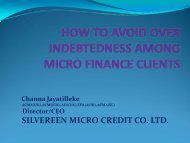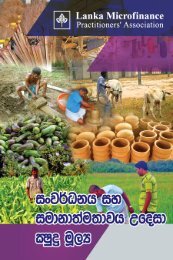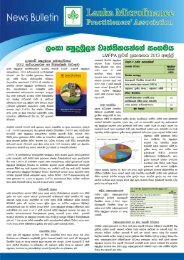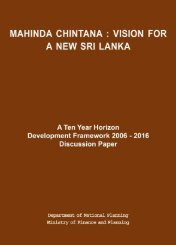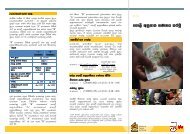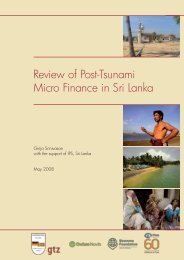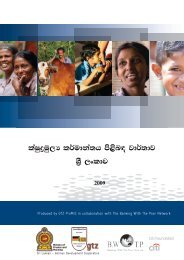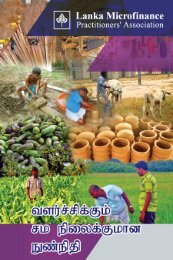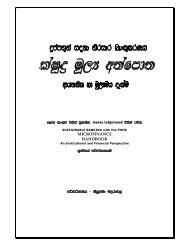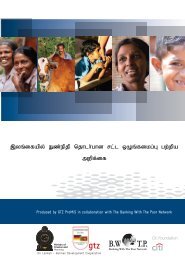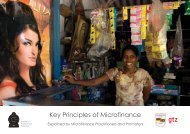National Microfinance Study of Sri Lanka: Survey of Practices and ...
National Microfinance Study of Sri Lanka: Survey of Practices and ...
National Microfinance Study of Sri Lanka: Survey of Practices and ...
Create successful ePaper yourself
Turn your PDF publications into a flip-book with our unique Google optimized e-Paper software.
In addition, it has initiated <strong>and</strong> supported the infrastructure <strong>of</strong> economically active<br />
village based societies, facilitating the growth <strong>of</strong> a rural capital base <strong>of</strong> over SLR<br />
733 million. Most importantly, it has provided the management <strong>and</strong> financial<br />
skills support for this capital base to be mobilised in over 888,000 loans, worth<br />
over 1.16 billion, to the rural people (ibid.).<br />
SEEDS provides a ‘credit plus’ service through three integrated divisions:<br />
The Banking Division administers the savings <strong>and</strong> credit service <strong>and</strong> supports<br />
the village societies.<br />
The Training Division is responsible for training the Sarvodaya society<br />
member borrowers <strong>and</strong> <strong>of</strong>ficials <strong>of</strong> SEEDS’ staff <strong>and</strong> other organisations in<br />
institutional development, enterprise development <strong>and</strong> micr<strong>of</strong>inance<br />
management.<br />
The Enterprise Services Division provides a range <strong>of</strong> business development<br />
services to SEEDS clients, including extension services, business<br />
advice/counselling, product development research, marketing advice <strong>and</strong><br />
private sector linkages.<br />
It has partnered with the State, the banking sector <strong>and</strong> other financial institutions<br />
in financing the rural sector. SEEDS’ looks to form constructive partnerships <strong>and</strong><br />
alliances with these organisations <strong>and</strong> projects both national <strong>and</strong> international.<br />
SEEDS’ has begun a programme to develop its Districts into ‘District Banks’.<br />
All districts will also become Enterprise Development Centres. These will<br />
continue the operations <strong>of</strong> the district, but as more <strong>of</strong> SEEDS operations <strong>and</strong><br />
activities are decentralized, the centres are becoming the focus <strong>of</strong> enterprise<br />
development in the area.<br />
They have discretion to grant credit, implement training programmes <strong>and</strong><br />
workshops <strong>and</strong> identify <strong>and</strong> request skills training modules. They also coordinate<br />
the initial stages <strong>of</strong> market linkages <strong>and</strong> partnerships. Their focus is on<br />
being responsive to the needs <strong>and</strong> requests <strong>of</strong> the people in the area, as well as<br />
providing innovative linkages <strong>and</strong> technologies.<br />
To increase the quality <strong>of</strong> services SEEDS Training Division provides, it is<br />
establishing ‘Centres <strong>of</strong> Excellence’ at three regional <strong>of</strong>fices. These centres will<br />
specialize in developing curricula, training programmes, libraries <strong>and</strong> other<br />
resources in the areas <strong>of</strong> management, entrepreneurship development <strong>and</strong><br />
institutional development.<br />
SEEDS savings are mobilised at SSS level. There are different types <strong>of</strong> savings<br />
products such as compulsory savings, ordinary savings, loan security savings,<br />
children’s savings available at these societies. SEEDS beneficiaries have access to<br />
variety <strong>of</strong> loan products. Of them loans from society savings fund <strong>and</strong> loans from<br />
SEEDS funds are two different loan schemes.<br />
The first type <strong>of</strong> loan is primarily issued for short-term credit needs <strong>and</strong> the<br />
second type is for medium term investment or other needs. A beneficiary can<br />
have two loans at a time from above two types <strong>and</strong> not more than one from one<br />
loan type.<br />
124



